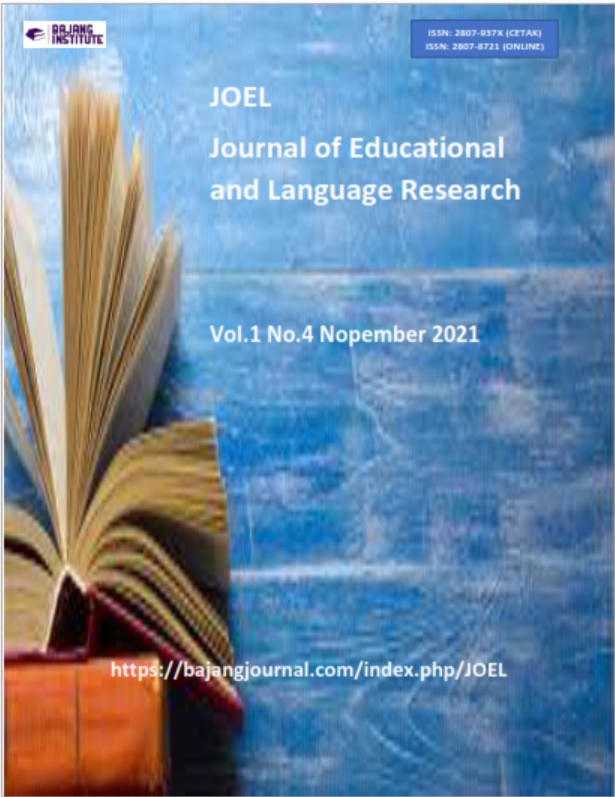AN ANALYSIS ON GRAMMATICAL ERRORS OF STUDENTS’ WRITINGS
DOI:
https://doi.org/10.53625/joel.v1i4.721Keywords:
Grammatical Errors, Surface Strategy Taxonomy, WritingsAbstract
The purpose of this descriptive study is to examine students' grammatical errors in their writings at Diponegoro University's First Semester Public Health Students. The target population consisted of 20 Public Health students of UNDIP enrolled in an English class who were chosen at random from a pool of 75. A writing assignment was conducted to asses the students grammatical errors based on surface strategy taxonomy. The results show the errors form the highest to the lowest percentage: misinformation (56,8%), omission (23,5%), addition (19,6%) and misordering (0%). Based on the results, it can be concluded that misinformation especially dealing with alternating forms is the most frequent errors made by students. This is caused by poor understanding of grammatical structure, lack of vocabulary mastery, and L1 direct translation tendencies
References
Kellogg, R. T. Training writing skills: A cognitive developmental perspective. 2008
A Team of Writers. English for University Teaching. Semarang; Badan Penerbit Universitas Diponegoro Semarang.xi 2001.
Calanoga, M. C. M., & Arellano - Tamayo, R. Error Analysis of Student Interns’ Reflective Journals: Basis for a Grammar Remediation Class. Asian EFL Journal, 23(3.2), 220–236. 2019
Afdaleni. Students’ Interest Level in Learning English Grammar. Asian EFL Journal, 20(4), 61–65. 2018
Marashi, H. Using Inductive and Deductive Consciousness Raising Tasks to Improve Field-Dependent and Field-Independent EFL Learners’ Grammar. The Iranian EFL Journal, 10(3), 60–74. 2014
Sioco, E. C., & Vera, Dr. P. V. D. Grammatical Competence of Junior High School Students. TESOL International Journal, 13(2), 82–94. 2018
Cam, L., & Tran, T. M. T. An Evaluation of using Games in Teaching English Grammar for First Year English-Majored Students at Dong Nai Technology University. International Journal of Learning, Teaching and Educational Research, 16(7), 55–71. 2017
Oshima, A. and Hogue, A. Writing Academic English. New York: Longman.
-45. 1999
Erdogan, V. Contribution of Error Analysis to Foreign Language Teaching. 2005
Brown, H.D. Principles of Language Learning and Teaching. 3rd Edition. Englewoods Cliffs, New Jersey: Prentice Hall Inc. 1994
Johnstone, K. M., Ashbaugh, H., & Warfield, T. D. Effects of repeated practice
and contextual-writing experiences on college students' writing skills. Journal ofEducational Psychology, 94 (2), 305. 2002
Alfiyani, L.M. (2013). An Analysis of Grammatical Errors in Writing among the Second Semester Students of English Department of Yogyakarta State University in the Academic Year 2011-2012. Yogyakarta.2013
Hendrawaty, N. and Saraswati, R. Recognizing Learner’s Potential in a Descriptive Paragraph. Developing Reflective English Language Teaching: Palembang. Sriwijaya University Press. 2016
Hendrawaty, Nurmala. An Analysis of Students Errors in Writing Sentence Patterns. Loquen: English Studies Journal, Volume 11, Number 01 June 2018, pp.63-68
Jampi, Tri Setyorini, Dewi Puspa, Masykuri, Edi Sunjayanto. The Grammatical Error Analysis Found in Students’ Compositon. Vol. 10 No.2 July – December
Pp. 28, 221-221
Bogdan, C and Biklen, K. Qualitative Research for Education. Boston: Advision of Sinn and Schuster, Inc.1992.30.











